Today, we visit Sanibel, Fla., where the average high temperature in March is 75 degrees, with little rain.
The City of Sanibel occupies a barrier island formed from accumulating sand in the Gulf of Mexico near Fort Myers. The indigenous Calusas, who first inhabited the island 2,500 years ago, died from diseases brought by the Spanish. Homesteaders began arriving in the 1860s and erected a still-standing lighthouse on the east end of the island in 1884, but the population remained low. By the 1950s, Sanibel Island contained only about 500 permanent residents. All that changed in 1963, when a causeway connected Sanibel to the mainland and developers followed, building condominiums, hotels and residences. A new causeway was built in 2007.
Today, Sanibel is home to 7,400 residents, with thousands more visiting each year, especially in the spring. The Sanibel government maintains strict control of the relaxing look and feel of the island, which has no high rises or traffic lights and only two chain restaurants, both there before the city’s 1974 incorporation. Half of Sanibel’s 33 square miles are wildlife sanctuaries. The largest, the 5,200-acre J.N. “Ding” Darling National Wildlife Refuse, harbors about 245 species of birds. Sanibel is famous for seashells that wash onto its sandy beaches, with hunched hunters displaying the “Sanibel Stoop.” The unique Bailey-Matthews National Shell Museum exhibits shells from around the world, many from Sanibel, as well as some living mollusks creating them.
The Sanibel Historical Museum and Village has assembled historic Sanibel buildings and chronicles the area’s history from the Calusas to today, providing information about African American contributions. Sanibel is home to many fine restaurants, with more found on Captiva, a small unincorporated island linked by bridge to Sanibel’s west end. Captiva is the launching point for day trips to Cabbage Key and Useppa (more next week).






